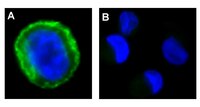Src kinase regulation by phosphorylation and dephosphorylation.
Roskoski, Robert
Biochem. Biophys. Res. Commun., 331: 1-14 (2005)
2005
Show Abstract
Src and Src-family protein-tyrosine kinases are regulatory proteins that play key roles in cell differentiation, motility, proliferation, and survival. The initially described phosphorylation sites of Src include an activating phosphotyrosine 416 that results from autophosphorylation, and an inhibiting phosphotyrosine 527 that results from phosphorylation by C-terminal Src kinase (Csk) and Csk homologous kinase. Dephosphorylation of phosphotyrosine 527 increases Src kinase activity. Candidate phosphotyrosine 527 phosphatases include cytoplasmic PTP1B, Shp1 and Shp2, and transmembrane enzymes include CD45, PTPalpha, PTPepsilon, and PTPlambda. Dephosphorylation of phosphotyrosine 416 decreases Src kinase activity. Thus far PTP-BL, the mouse homologue of human PTP-BAS, has been shown to dephosphorylate phosphotyrosine 416 in a regulatory fashion. The platelet-derived growth factor receptor protein-tyrosine kinase mediates the phosphorylation of Src Tyr138; this phosphorylation has no direct effect on Src kinase activity. The platelet-derived growth factor receptor and the ErbB2/HER2 growth factor receptor protein-tyrosine kinases mediate the phosphorylation of Src Tyr213 and activation of Src kinase activity. Src kinase is also a substrate for protein-serine/threonine kinases including protein kinase C (Ser12), protein kinase A (Ser17), and CDK1/cdc2 (Thr34, Thr46, and Ser72). Of the three protein-serine/threonine kinases, only phosphorylation by CDK1/cdc2 has been demonstrated to increase Src kinase activity. Although considerable information on the phosphoprotein phosphatases that catalyze the hydrolysis of Src phosphotyrosine 527 is at hand, the nature of the phosphatases that mediate the hydrolysis of phosphotyrosine 138 and 213, and phosphoserine and phosphothreonine residues has not been determined. | 15845350
 |
Src family kinases, key regulators of signal transduction.
Parsons, Sarah J and Parsons, J Thomas
Oncogene, 23: 7906-9 (2004)
2004
Show Abstract
The Src family of protein tyrosine kinases (SFKs) plays key roles in regulating signal transduction by a diverse set of cell surface receptors in the context of a variety of cellular environments. SFKs have evolved many ingenious molecular strategies to couple receptors with the cytoplasmic signaling machinery. The contributions to this issue of ONCOGENE describe how this machinery regulates fundamental cellular processes, including cell growth, differentiation, cell shape, migration and survival, and specialized cell signals. The pleiotropic functions of Src and Src family members underscore the importance of these kinases and explain why many of the members of this family have been identified as cellular oncogenes. In this volume, we have attempted to provide the reader with an overview of the current understanding of the function of Src family kinases in the regulation of selected cellular signaling pathways. | 15489908
 |
Structure and regulation of Src family kinases.
Boggon, Titus J and Eck, Michael J
Oncogene, 23: 7918-27 (2004)
2004
Show Abstract
Src family kinases are prototypical modular signaling proteins. Their conserved domain organization includes a myristoylated N-terminal segment followed by SH3, SH2, and tyrosine kinase domains, and a short C-terminal tail. Structural dissection of Src kinases has elucidated the canonical mechanisms of phosphotyrosine recognition by the SH2 domain and proline-motif recognition by the SH3 domain. Crystallographic analysis of nearly intact Src kinases in the autoinhibited state has shown that these protein interaction motifs turn inward and lock the kinase in an inactive conformation via intramolecular interactions. The autoinhibited Src kinase structures reveal a mode of domain assembly used by other tyrosine kinases outside the Src family, including Abl and likely Tec family kinases. Furthermore, they illustrate the underlying regulatory principles that have proven to be general among diverse modular signaling proteins. Although there is considerable structural information available for the autoinhibited conformation of Src kinases, how they may assemble into active signaling complexes with substrates and regulators remains largely unexplored. | 15489910
 |












